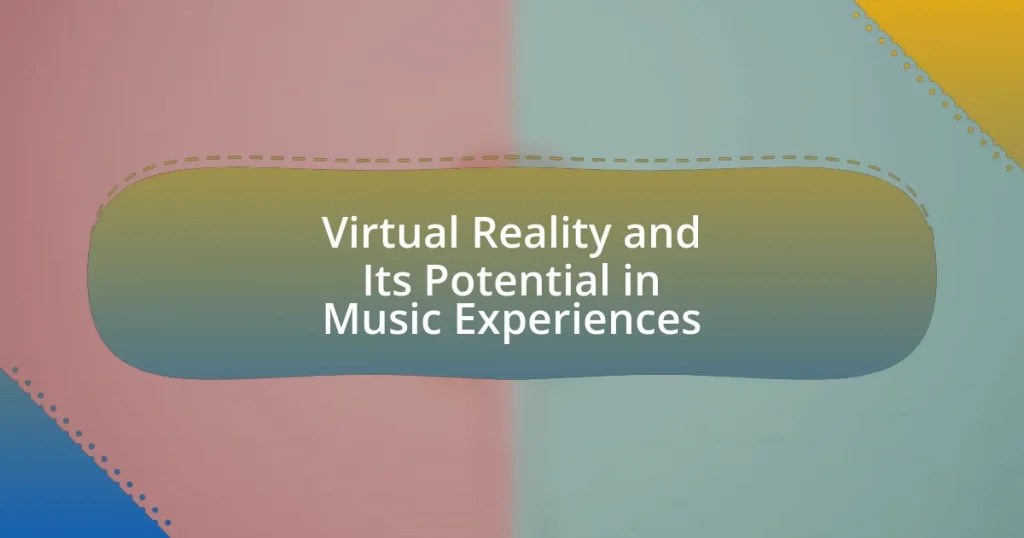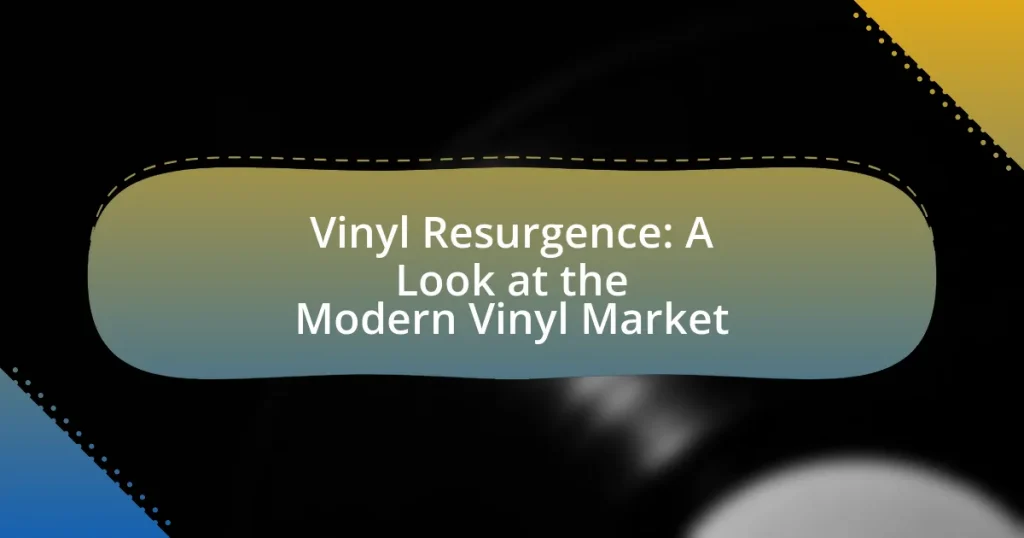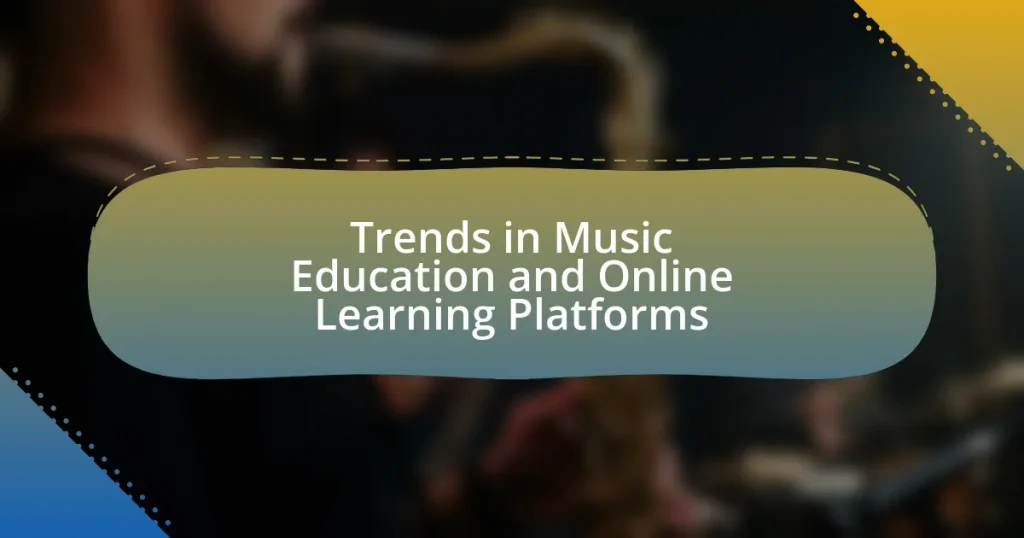The article focuses on the importance of diversity and inclusion in the music industry, emphasizing their role in fostering creativity, innovation, and representation. It highlights the current challenges, such as systemic barriers and underrepresentation of women and racial minorities, while presenting research that shows diverse teams lead to better financial performance and audience engagement. The article also discusses strategies for promoting diversity, including targeted recruitment, mentorship initiatives, and the impact of diverse music festivals. Additionally, it outlines measurable outcomes for assessing diversity efforts and provides examples of successful programs within the industry.
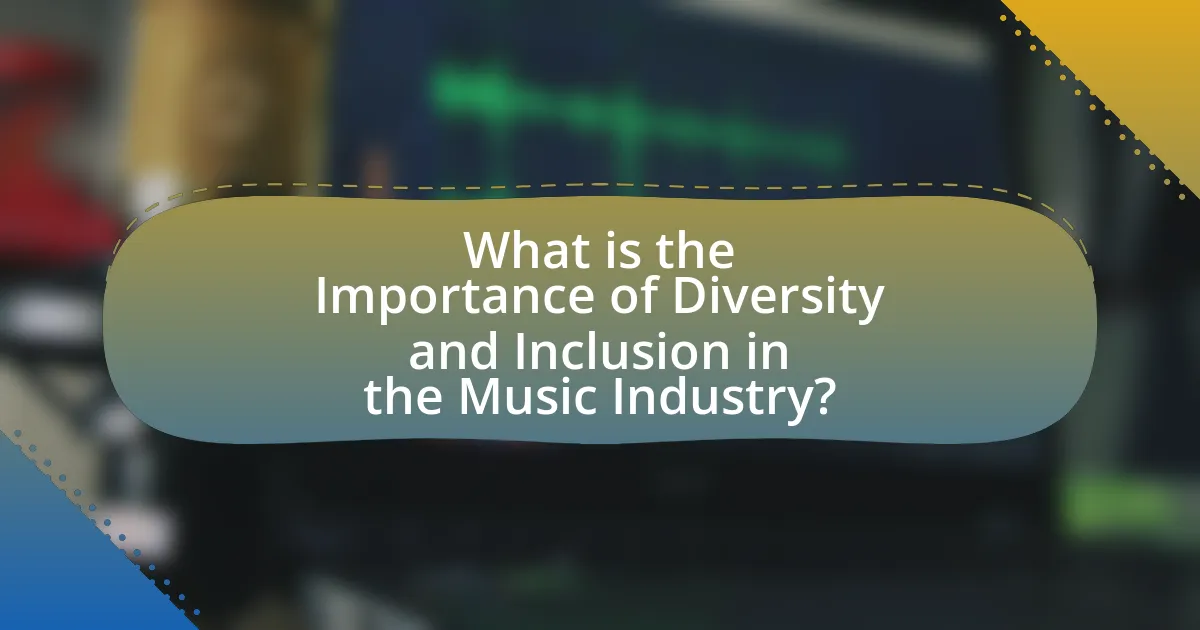
What is the Importance of Diversity and Inclusion in the Music Industry?
Diversity and inclusion in the music industry are crucial for fostering creativity, innovation, and representation. A diverse music industry reflects a wide range of cultural perspectives, which enhances artistic expression and connects with broader audiences. Research by the USC Annenberg Inclusion Initiative found that only 22.5% of artists on the Billboard Hot 100 were women from 2012 to 2019, highlighting the need for increased representation. Furthermore, inclusive practices can lead to better financial performance; a McKinsey report indicates that companies in the top quartile for gender diversity are 21% more likely to outperform their counterparts in profitability. Thus, prioritizing diversity and inclusion not only enriches the music landscape but also drives economic success.
Why is diversity and inclusion crucial for the music industry?
Diversity and inclusion are crucial for the music industry because they foster creativity, innovation, and a broader audience appeal. A diverse workforce brings varied perspectives and experiences, which can lead to unique musical styles and collaborations that resonate with different demographics. For instance, research by the USC Annenberg Inclusion Initiative found that music charts dominated by diverse artists tend to perform better commercially, indicating that inclusivity not only enriches the artistic landscape but also drives financial success. Furthermore, inclusive practices can enhance the industry’s reputation and attract a wider range of talent, ultimately contributing to a more vibrant and sustainable music ecosystem.
How do diversity and inclusion impact creativity in music?
Diversity and inclusion significantly enhance creativity in music by fostering a broader range of perspectives and ideas. When musicians from various backgrounds collaborate, they bring unique cultural influences, experiences, and techniques that can lead to innovative sounds and compositions. Research by the National Endowment for the Arts indicates that diverse teams produce more original work, as they challenge conventional norms and inspire each other to explore new artistic directions. This collaborative environment not only enriches the creative process but also resonates with a wider audience, reflecting the multifaceted nature of society.
What role does diversity play in audience engagement?
Diversity plays a crucial role in audience engagement by enhancing relatability and broadening appeal. When audiences see themselves represented in music, they are more likely to connect emotionally with the content, leading to increased loyalty and participation. Research indicates that diverse representation in media can lead to higher viewer engagement; for instance, a study by the Annenberg Inclusion Initiative found that films with diverse casts perform better at the box office, suggesting that audiences are drawn to inclusive narratives. This principle applies to the music industry, where diverse artists can attract varied demographics, fostering a more engaged and invested audience.
What are the current challenges regarding diversity and inclusion in the music industry?
The current challenges regarding diversity and inclusion in the music industry include systemic barriers, lack of representation, and unequal access to opportunities. Systemic barriers manifest in hiring practices that favor established networks, often sidelining diverse talent. For instance, a 2021 report by the Annenberg Inclusion Initiative found that only 21.6% of artists on the Billboard Hot 100 were women, highlighting the gender disparity. Additionally, racial and ethnic minorities face significant underrepresentation; a study by the USC Annenberg School for Communication and Journalism revealed that only 18.6% of artists in popular music were from underrepresented racial and ethnic groups. These statistics underscore the ongoing struggle for equitable representation and opportunities within the industry.
What barriers do underrepresented groups face in the music industry?
Underrepresented groups in the music industry face barriers such as limited access to funding, lack of representation in decision-making roles, and systemic biases that hinder their opportunities for exposure and success. For instance, a report by the Annenberg Inclusion Initiative found that only 21.7% of artists on the Billboard Hot 100 from 2012 to 2019 were women, highlighting gender disparity. Additionally, a study by the Music Industry Research Association indicated that racial and ethnic minorities are often underrepresented in key industry roles, which perpetuates a cycle of exclusion. These barriers contribute to an environment where diverse voices struggle to gain recognition and support.
How does systemic bias affect opportunities for diverse artists?
Systemic bias significantly limits opportunities for diverse artists by perpetuating unequal access to resources, platforms, and recognition within the music industry. This bias manifests through hiring practices, funding allocations, and promotional efforts that favor established, often non-diverse artists over emerging talent from underrepresented backgrounds. For instance, a study by the Annenberg Inclusion Initiative found that only 21.7% of artists on the Billboard Hot 100 between 2012 and 2019 were women, highlighting a gender disparity that reflects broader systemic biases. Additionally, diverse artists often face barriers in securing contracts and airplay, as industry gatekeepers may unconsciously favor familiar or mainstream sounds, further entrenching the lack of diversity.
How can the music industry benefit from embracing diversity and inclusion?
The music industry can benefit from embracing diversity and inclusion by enhancing creativity and broadening market appeal. Diverse perspectives lead to innovative sounds and styles, which can attract a wider audience. For instance, research from the USC Annenberg Inclusion Initiative found that diverse teams in the entertainment sector produce more commercially successful content. Additionally, inclusive practices can improve artist representation, fostering a sense of belonging among underrepresented groups, which can lead to increased loyalty and engagement from fans. This approach not only enriches the cultural landscape but also drives economic growth within the industry.
What positive outcomes have been observed in diverse music teams?
Diverse music teams have been observed to produce enhanced creativity and innovation. Research indicates that teams with varied backgrounds generate a wider range of ideas and perspectives, leading to more original compositions and unique soundscapes. For instance, a study published in the Journal of Business Research found that diversity in teams correlates with increased creativity, as members contribute distinct cultural influences and experiences. Additionally, diverse teams often exhibit improved problem-solving abilities, as they can approach challenges from multiple angles, resulting in more effective solutions. This dynamic fosters a richer artistic environment, ultimately benefiting the music industry as a whole.
How does inclusion enhance the overall music experience for listeners?
Inclusion enhances the overall music experience for listeners by broadening the range of perspectives and cultural expressions represented in music. This diversity allows listeners to connect with a wider array of emotions and stories, fostering empathy and understanding across different backgrounds. Research indicates that diverse musical influences can lead to increased creativity and innovation in music production, which enriches the listening experience. For example, a study published in the Journal of Cultural Economics found that music that incorporates diverse cultural elements tends to attract larger audiences and receive higher critical acclaim, demonstrating that inclusion not only benefits artists but also enhances the enjoyment and appreciation of music for listeners.
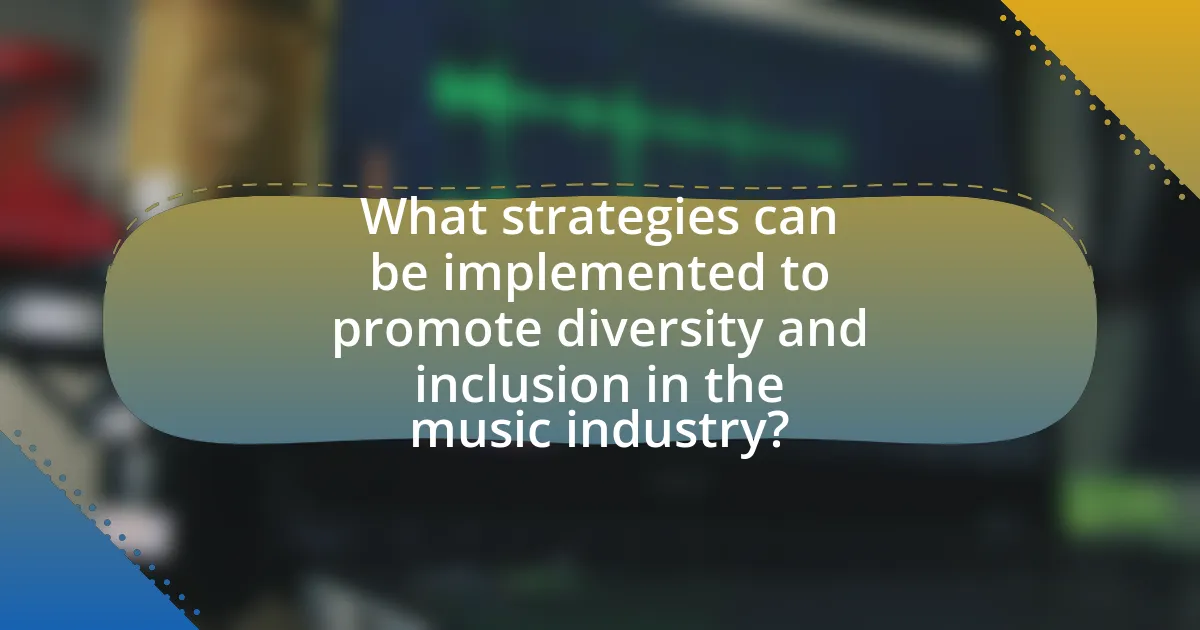
What strategies can be implemented to promote diversity and inclusion in the music industry?
To promote diversity and inclusion in the music industry, organizations can implement targeted recruitment initiatives that focus on underrepresented groups. These initiatives can include partnerships with diverse music schools and community organizations to create pathways for marginalized artists. Research indicates that diverse teams lead to increased creativity and innovation, as seen in a McKinsey report which found that companies in the top quartile for gender diversity are 21% more likely to outperform on profitability. Additionally, establishing mentorship programs that connect established artists with emerging talent from diverse backgrounds can foster an inclusive environment. Implementing equitable pay practices and transparent hiring processes further supports diversity, as evidenced by the 2020 Music Industry Report, which highlighted the need for fair compensation to retain diverse talent.
How can music organizations create inclusive environments?
Music organizations can create inclusive environments by implementing diverse hiring practices, fostering community engagement, and providing accessible resources. Diverse hiring practices ensure representation across various demographics, which can lead to a broader range of perspectives and creativity in music. For instance, organizations that actively recruit from underrepresented groups can enhance their cultural relevance and appeal.
Fostering community engagement involves collaborating with local artists and organizations to create programs that reflect the community’s diversity. This approach not only builds trust but also encourages participation from a wider audience.
Providing accessible resources, such as scholarships, mentorship programs, and workshops tailored for marginalized groups, can further support inclusivity. Research indicates that organizations that prioritize inclusivity see improved innovation and audience engagement, as diverse teams are more likely to produce unique and relatable content.
What training programs can help foster diversity awareness?
Training programs that can help foster diversity awareness include unconscious bias training, cultural competency workshops, and diversity and inclusion seminars. Unconscious bias training educates participants about implicit biases that affect decision-making and interactions, which is crucial in the music industry where diverse perspectives are essential for creativity and innovation. Cultural competency workshops enhance understanding of different cultural backgrounds, promoting respect and collaboration among diverse teams. Diversity and inclusion seminars provide frameworks for creating inclusive environments, addressing systemic barriers, and implementing equitable practices. Research indicates that organizations with diversity training programs see improved employee engagement and innovation, highlighting the effectiveness of these initiatives in fostering a more inclusive culture.
How can mentorship initiatives support underrepresented artists?
Mentorship initiatives can support underrepresented artists by providing them with access to industry knowledge, networking opportunities, and personalized guidance. These initiatives often connect emerging artists with established professionals who can share insights on navigating the music industry, which is crucial for those who may lack resources or connections. For instance, a study by the National Endowment for the Arts found that mentorship can significantly enhance career development and artistic growth, particularly for marginalized groups. By fostering relationships that encourage skill development and confidence, mentorship initiatives play a vital role in promoting diversity and inclusion within the music industry.
What role do music festivals and events play in promoting diversity?
Music festivals and events play a crucial role in promoting diversity by providing a platform for artists from various cultural backgrounds to showcase their talents. These events often feature a wide range of musical genres, reflecting the diverse influences and traditions of different communities. For instance, festivals like Coachella and Glastonbury have increasingly included artists from underrepresented groups, thereby fostering inclusivity and broadening audience perspectives. Additionally, studies have shown that diverse lineups can enhance audience engagement and satisfaction, as attendees are exposed to a richer array of cultural expressions. This not only supports the artists but also cultivates a more inclusive music industry overall.
How can festival lineups reflect a commitment to diversity?
Festival lineups can reflect a commitment to diversity by featuring a wide range of artists from various backgrounds, including different races, genders, sexual orientations, and cultural heritages. This approach not only showcases diverse musical genres but also promotes representation and inclusivity within the music industry. For instance, festivals like Coachella and Glastonbury have made concerted efforts to include more female artists and artists of color in their lineups, which has been documented in reports highlighting the gender disparity in music festivals. According to a 2020 study by the Annenberg Inclusion Initiative, only 22.5% of artists at major music festivals were women, indicating a significant gap that festivals can address by prioritizing diversity in their programming.
What impact do diverse events have on community engagement?
Diverse events significantly enhance community engagement by fostering inclusivity and encouraging participation from various demographic groups. These events create opportunities for individuals from different backgrounds to connect, share experiences, and collaborate, which strengthens social bonds within the community. Research indicates that communities hosting diverse cultural events experience increased civic participation, as seen in studies conducted by the National Endowment for the Arts, which found that diverse programming leads to higher attendance and involvement in local initiatives. This engagement not only enriches the community’s cultural fabric but also promotes understanding and respect among its members.
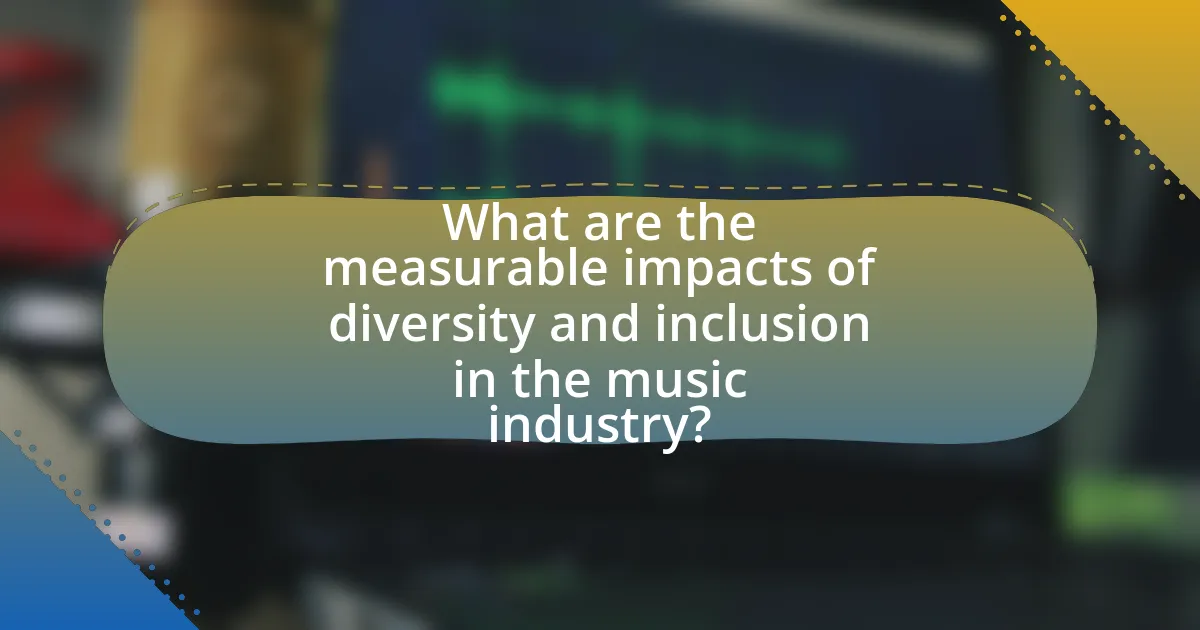
What are the measurable impacts of diversity and inclusion in the music industry?
Diversity and inclusion in the music industry lead to increased creativity, broader audience engagement, and improved financial performance. Research indicates that diverse teams are 35% more likely to outperform their peers in terms of profitability, as shown in a study by McKinsey & Company. Additionally, inclusive practices can enhance the representation of underrepresented groups, resulting in a wider variety of musical genres and styles that resonate with diverse audiences. For instance, the rise of genres like reggaeton and K-pop illustrates how diversity can drive global music trends and expand market reach. Furthermore, organizations that prioritize diversity report higher employee satisfaction and retention rates, which contribute to a more stable and innovative workforce.
How can success in diversity and inclusion be evaluated?
Success in diversity and inclusion can be evaluated through measurable outcomes such as workforce demographics, employee engagement surveys, and retention rates. Organizations can analyze the representation of diverse groups within their workforce compared to industry benchmarks, ensuring alignment with broader societal demographics. Employee engagement surveys can provide insights into the inclusivity of the workplace culture, revealing how valued employees feel regardless of their background. Additionally, tracking retention rates of diverse employees can indicate the effectiveness of inclusion initiatives, as higher retention often correlates with a supportive environment. These metrics collectively offer a comprehensive view of an organization’s success in fostering diversity and inclusion.
What metrics can be used to assess diversity in music organizations?
Metrics that can be used to assess diversity in music organizations include demographic representation, recruitment and retention rates, and pay equity analysis. Demographic representation measures the percentage of individuals from various backgrounds, such as race, gender, and ethnicity, within the organization compared to the broader community or industry standards. Recruitment and retention rates track the hiring and ongoing employment of diverse candidates, indicating the organization’s effectiveness in attracting and maintaining a diverse workforce. Pay equity analysis examines salary disparities among different demographic groups to ensure fair compensation practices. These metrics provide a comprehensive view of diversity and highlight areas for improvement within music organizations.
How do audience demographics change with increased diversity?
Increased diversity in the music industry leads to a broader and more varied audience demographic. As diverse artists emerge, they attract listeners from different cultural, ethnic, and socioeconomic backgrounds, resulting in a more inclusive fan base. For example, a study by Nielsen Music in 2019 found that genres like hip-hop and Latin music have seen significant growth in audience engagement, reflecting the increasing diversity of listeners. This shift not only enhances the representation of various communities but also influences music consumption patterns, as diverse audiences seek out music that resonates with their identities and experiences.
What best practices can be adopted for ongoing diversity and inclusion efforts?
Ongoing diversity and inclusion efforts can adopt best practices such as implementing comprehensive training programs, establishing diverse hiring practices, and fostering an inclusive workplace culture. Comprehensive training programs educate employees about unconscious bias and cultural competency, which can lead to a more aware and respectful environment. Diverse hiring practices ensure that recruitment processes actively seek candidates from various backgrounds, thereby increasing representation. Fostering an inclusive workplace culture involves creating policies that promote equity and support for all employees, which has been shown to enhance creativity and innovation in organizations. According to a McKinsey report, companies in the top quartile for gender diversity on executive teams are 21% more likely to experience above-average profitability, highlighting the tangible benefits of these practices.
How can organizations ensure accountability in diversity initiatives?
Organizations can ensure accountability in diversity initiatives by establishing clear metrics and regular reporting mechanisms. By setting specific, measurable goals related to diversity, such as increasing representation of underrepresented groups in leadership roles by a certain percentage within a defined timeframe, organizations can track progress effectively. Regularly publishing diversity reports that outline achievements and areas for improvement fosters transparency and encourages stakeholder engagement. Research from McKinsey & Company indicates that companies with diverse leadership teams are 33% more likely to outperform their peers on profitability, reinforcing the importance of accountability in achieving diversity objectives.
What are some examples of successful diversity programs in the music industry?
Successful diversity programs in the music industry include initiatives like the Recording Academy’s “Diversity and Inclusion Task Force,” which aims to increase representation across all levels of the music community. Another example is the “Women in Music” initiative by the organization of the same name, which focuses on empowering women in the industry through mentorship and networking opportunities. Additionally, the “Music Industry Black Out” movement, which emerged in 2020, has led to commitments from major labels to improve diversity and equity within their organizations. These programs have resulted in measurable increases in the hiring and promotion of underrepresented groups within the industry.
What practical steps can individuals take to support diversity and inclusion in music?
Individuals can support diversity and inclusion in music by actively promoting and participating in diverse musical events and initiatives. This includes attending concerts and festivals that feature artists from underrepresented backgrounds, thereby increasing their visibility and support. Additionally, individuals can advocate for equitable representation in music education and industry opportunities, such as mentoring programs for aspiring musicians from diverse communities. Research indicates that diverse teams in creative industries lead to more innovative outcomes, highlighting the importance of varied perspectives in music creation and production. By engaging with and amplifying diverse voices, individuals contribute to a more inclusive music landscape.













